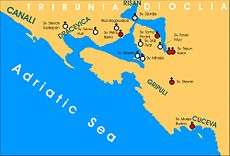Grbalj
Grbalj (Montenegrin and Serbian Cyrillic: Грбаљ) is a historical region, Serb tribe, a field between Budva and the Luštica peninsula, in seaside Montenegro. It is a fertile region[1] surrounded by the Lovćen to the east, and to the west the low hills separate the region from the Adriatic.
Geography
In the east frontier of the field, ten villages have developed, collectively referred to as Upper Grbalj. Lower Grbalj constituted the villages on the western edge of the field. The Bigova village, situated in a cove with the same name, is the only place on the coast.
Villages located in Grbalj are Bigova, Bratešići, Višnjeva, Vranovići, Glavati, Glavatičići, Gorovići, Dub, Zagora, Kovači, Krimovica, Kubasi, Lješevići, Nalježići, Pelinovo, Pobrđe, Prijeradi, Sutvara, Trešnjica, Ukropci, Šišići and Mačić.
The Adriatic highway goes through Grbalj. After its construction, and the 1979 earthquake, several settlements were established along it.
Economy
The region is an important agricultural area. The southern part of the field consists of orchards, vineyards and vegetable gardens. This part of the field ends with the Jaz beach. In the northern part of the Grbalj field, lies the industrial area of Kotor.
History
Middle Ages

Grbalj was a župa (county) of the medieval Serbian state under the Nemanjić dynasty. It was the personal estate of Stefan Vukanović Nemanjić (fl. 1252).
In 1497 Firuz Beg captured Grbalj and put Zeta under his effective military control, although it was still part of the Zeta governed by Stefan II Crnojević.[2]
Ottoman period
The Ottoman census of 1582–83 registered the "vilayet of the Black Mountain" (vilayet-i Kara Dağ), part of the Sanjak of Scutari, as having the following nahiyah, with number of villages: Grbavci with 13 villages, Župa with 11, Malonšići with 7, Pješivci with 14, Cetinje with 16, Rijeka with 31, Crmnica with 11, Paštrovići with 36 and Grbalj with 9 villages; a total of 148 villages.[3]
Contemporary history
In 1970, football club OFK Grbalj was founded in Kotor.
Culture
The Serbian Orthodox Podlastva monastery lies in Grbalj. People from Grbalj are known by the demonym Grbljani and are often perceived as a clan.
Overall, in Montenegro, the Nemanjić cult was more widespread than that of Prince Lazar's, though in Grbalj, the latter cult became particularly popular, with the locals claiming Lazar as a native.[4]
Notable people
- Svetozar Marović, Yugoslav politician, born in Kotor
- Mitrofan Ban, Orthodox bishop, born in Glavati
- Lazo M. Kostić, Montenegrin Serb lawyer, historian and publicist
- Đorđe Mihailović, keeper of the Serbian Military Cemetery at Zeitenlik
- Ivica Kralj, football goal keeper, born in Tivat
- Milan Tičić, water polo player, born in Budva
References
- ↑ Nebojša Tomašević (1982). Treasures of Yugoslavia: An Encyclopedic Touring Guide. Yugoslaviapublic.
- ↑ Pavle S. Radusinović 1978, p. 44.
- ↑ Vasić, Milan (1991), "Etnički odnosi u jugoslovensko-albanskom graničnom području prema popisnom defteru sandžaka Skadar iz 1582/83. godine", Stanovništvo slovenskog porijekla u Albaniji : zbornik radova sa međunarodnog naučnog skupa održanog u Cetinju 21, 22. i 23. juna 1990 (in Serbo-Croatian), OCLC 29549273
- ↑ Milosav Babović (1990). Kosovski boj u istoriji, tradiciji i stvaralaštvu Crne Gore: zbornik radova : radovi sa naučnog skupa održanog u Titogradu 25. oktobr 1989. godine u organizaciji Crnogorske akademije nauka i umjetnosti, Istorijskog instituta SR Crne Gore i Filozofskog fakulteta u Nikšiću. Crnogorska akademija nauka i umjetnosti. p. 252. ISBN 978-86-419-0120-7.
